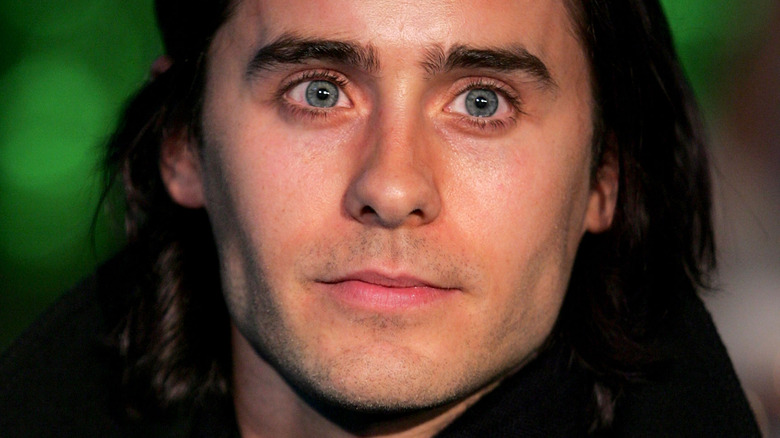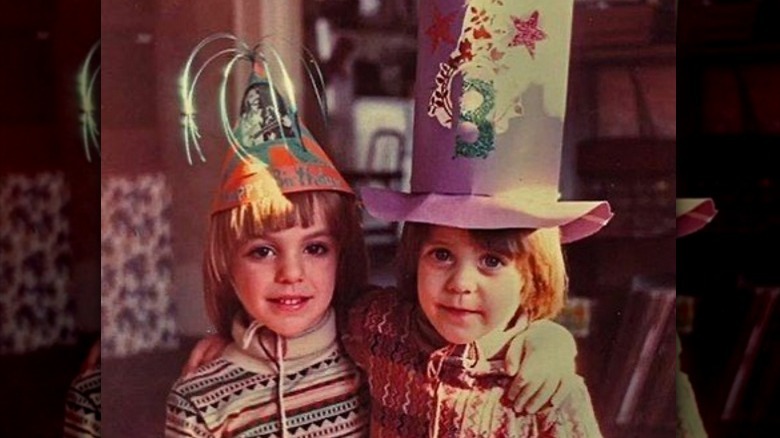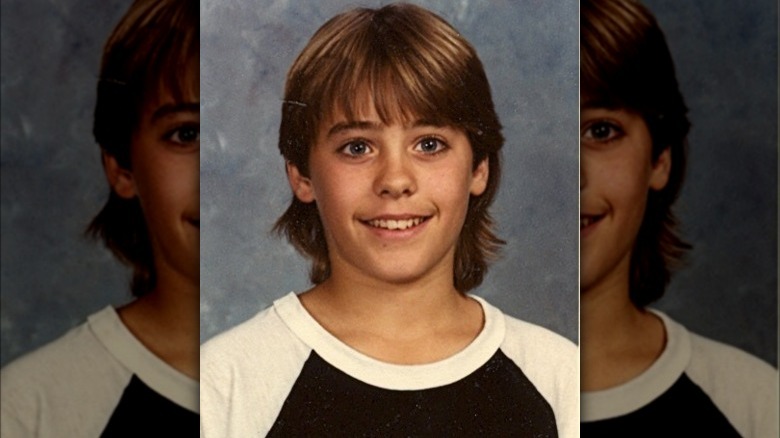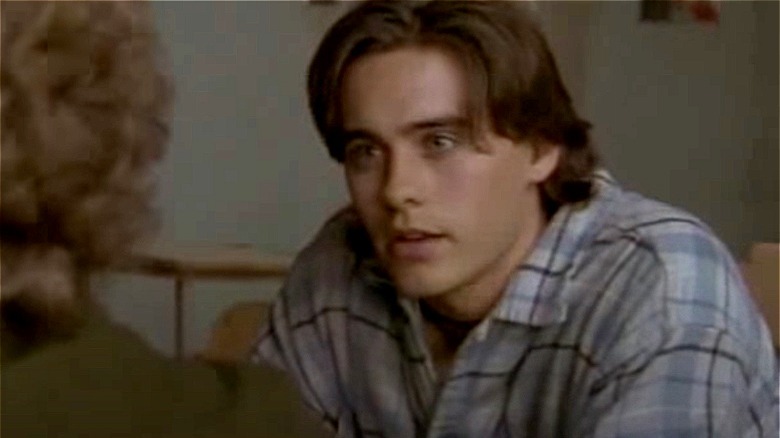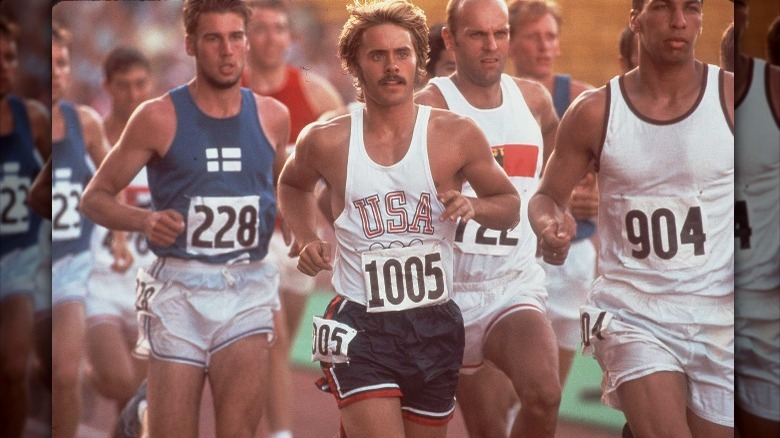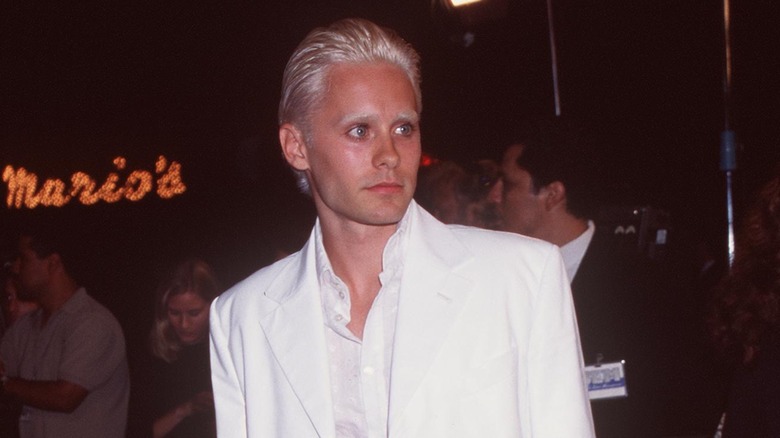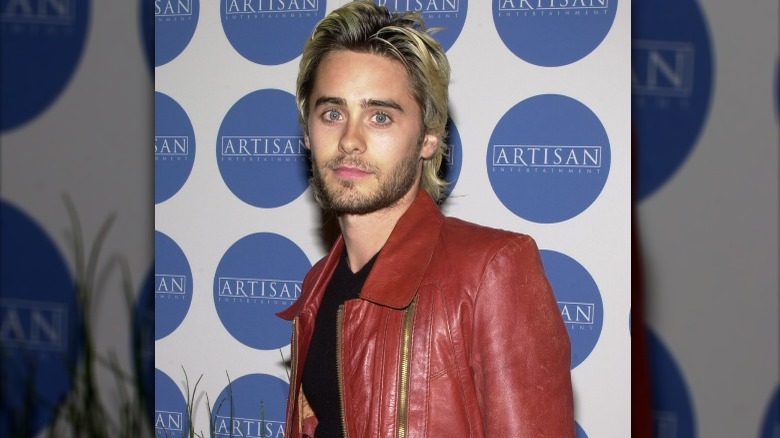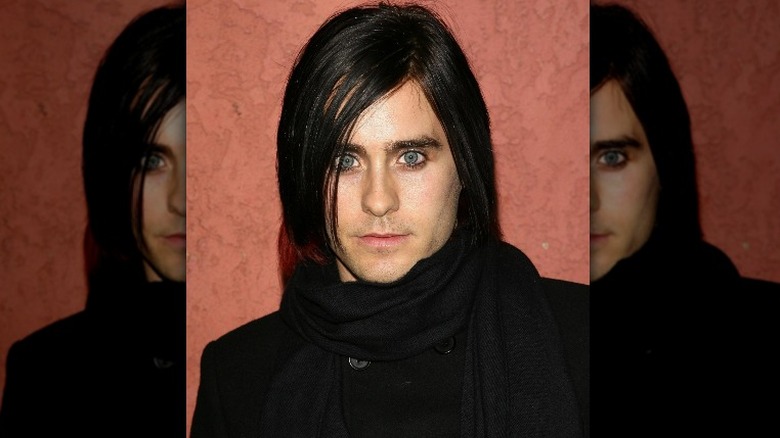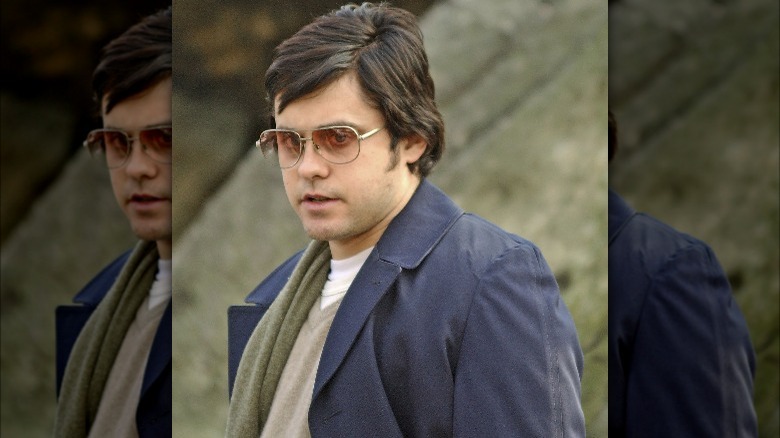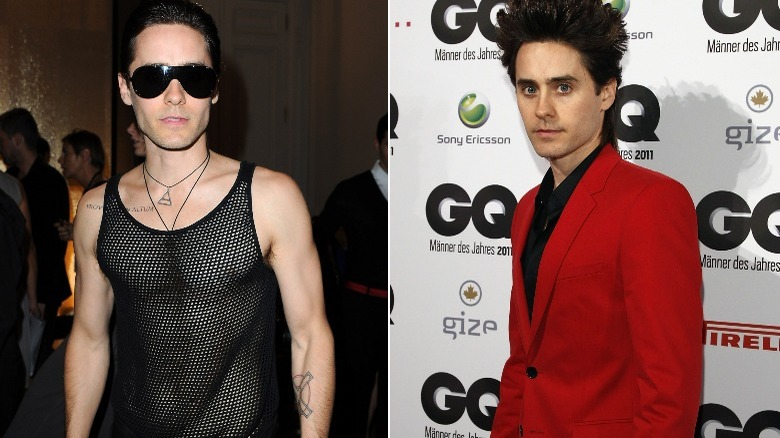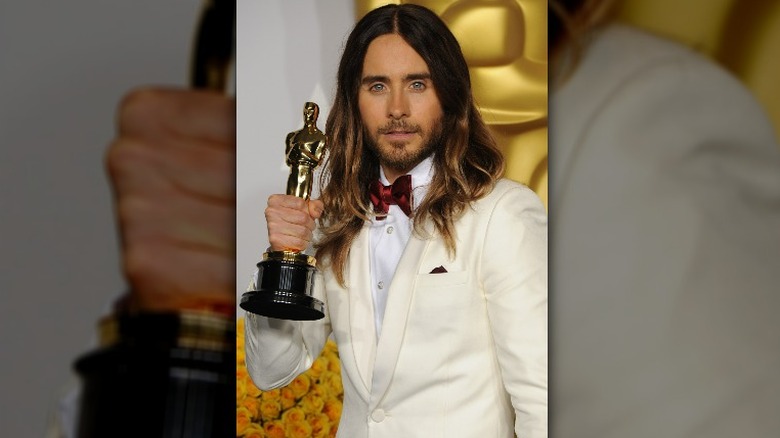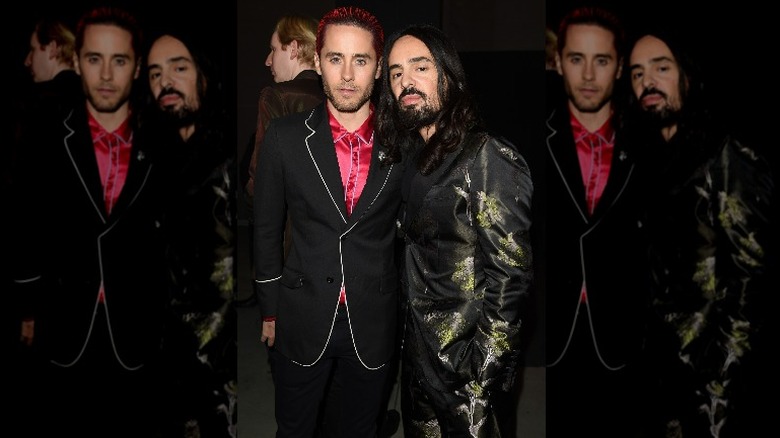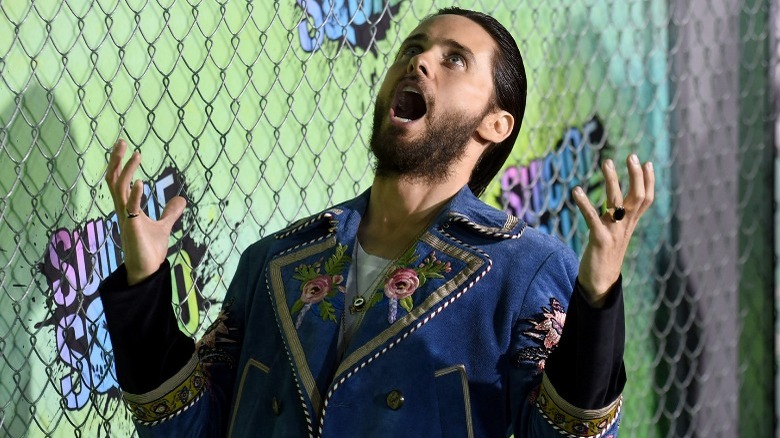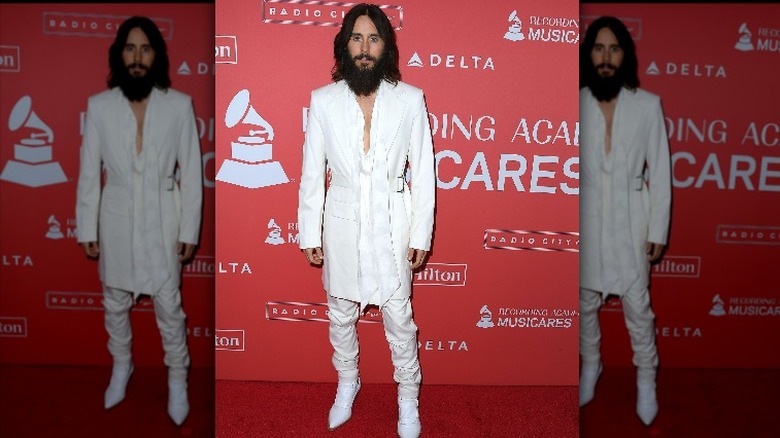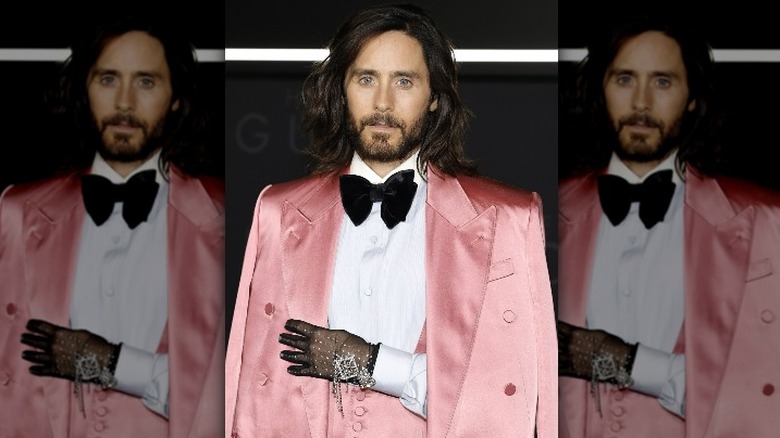The Transformation Of Jared Leto From Childhood To 51
This article contains references to suicide, drug use, and extreme weight gain and weight loss.
From one role to the next, and with each and every strange new course of his personal reinvention, the transformation of Jared Leto has been one of Hollywood's more outlandish evolutions. His mysterious and deeply private public persona is one that lends itself to an idiosyncratic rendering of his own celebrity. As such, he remains something of a pop culture litmus test for how audiences know him best: Is he the goth prophet of 30 Seconds to Mars? The metamorphic artist? The ribald red carpet raconteur? Or simply the dude from the Gucci adverts?
In interviews, even Leto has often seemed perplexed by his own identity and it's mutable nature — and more than willing to confuse others about it, too. Having once described himself as a "maniacal narcissist" to Rolling Stone, the star has gained himself a reputation in the media for being evasive yet self-involved; a star who loves to deliver misdirection while always maintaining attention on himself. As a frustrated The Telegraph interview with Leto once proposed based on his behavior, "Either you dismiss Jared Leto as a big jerk ... or go with it, like eating novelty sweets with no nutritional value — irritating and addictive at the same time."
Who exactly is Leto, and how did he get where he is today? Go "method" with some guyliner and the most luxurious wig of ombré you can find and get deep into character, because this is the transformation of Leto from childhood to 51.
The traveling Letos
Jared Leto's pastoral approach as an artist — drifting between characters, forms, identities, and stories — likely started when he was a child. Per The Telegraph, the actor and musician lived "a nomad's life" with his mom and brother Shannon Leto, where they "moved around a lot," making temporary homes "everywhere from Wyoming to Virginia to Colorado, even South America."
As underlined by his emotional 2014 Oscar speech, the star grew up poor but happy, and once affectionately joked that his mom essentially carried him and his brother "in one hand and a fistful of food stamps in the other" to Interview. Casting a further potential shadow on his childhood was an absentee father, who Newshub reported as having walked out on the family soon after Jared was born. When the actor was eight, his father died of suicide.
Luckily, Jared and his brother were raised in an artistic atmosphere among their mom's extensive art friends who encouraged the two kids to feel, as Shannon put it in Rolling Stone, "no boundaries" in regards to expressing their creativity. Clearly, it paid off. It may also go some way as to explaining Jared's propensity to get creative with his own story. The actor confessed to Rolling Stone that, on occasion, he'd been willfully deceptive regarding details of his childhood. "I lied about it so much, I don't know what the truth is," he said, noting that he was inspired by River Phoenix's approach to lying "as much as possible" in interviews.
If you or anyone you know is having suicidal thoughts, please call the National Suicide Prevention Lifeline at 1-800-273-TALK (8255).
College didn't take for Jared Leto
Having spent his childhood being nurtured in the many languages of the arts, Jared Leto came of age seasoned with creative ambition. In Manhattan, he attended the School of Visual Arts where he'd lost himself in the process of creating work. When it came to photography, he told Rolling Stone, "I would go in the darkroom and come out, like, eight hours later."
Meanwhile, his process for painting sounded equally as immersive and substantial, with the star informing The Telegraph that he was "interested in scale" more than anything else, resulting in "paintings that were five or six storeys high." It stands to reason then that Leto would later become renowned for acting work which would involve a method process equivalent to creating "five or six storeys" worth of a painting. But first, he'd have to get to Hollywood.
To do so, he'd first discover that film was his mother tongue during his third year at college, where he focused on "video art," as he explained to James Franco for Interview. "But then I dropped out because I thought I would have a better chance at directing a film if I got a job as an actor first." Leto jumped ship to California, where he slept on a beach in Venice "with a backpack and a couple of hundred bucks in my pocket." It was a bold move, but it paid off.
I'm totally over Jordan Catalano
At 21, Jared Leto was cast in the cult teen show "My So-Called Life," as Jordan Catalano, a floppy-haired, flannel-clad dreamboat who leaned on things better than any man in history. Speaking to Elle, the show's creator Winnie Holzman recalled the aspiring filmmaker was "reluctant" about taking the role as he wasn't yet completely sold on acting yet. They asked him to "lean against a wall and close his eyes" during the audition and from then on, the show couldn't exist without him.
The actor wasn't initially cast as a series regular, but Holtzman explained to Entertainment Weekly that "his presence ... was so magnetic" that they "knew the stories would always include him." And thus, young women the world over swooned in unison over boiler room fantasies involving the young star.
Leto's depiction of the character remains one of the most powerful teen idol creations of all time. Rolling Stone even mused that the actor was "objectified" in the show, playing "a lust-object role usually reserved for women" — a fact which Leto took his stride, responding — perhaps sarcastically — "It was about time. I'm happy to have taken that, uh, baton or whatever." Sadly, the show hasn't remained a point of pride for the actor, who's avoided commenting on it in interviews and even missed a "My So-Called Life" reunion with the cast in 2020. By 1995, he was ready to destroy his pretty boy image however he could.
Run, Jared Leto, run
To the heartbreak of misunderstood bad boy enthusiasts everywhere, "My So Called Life" was cancelled after just one season, per Los Angeles Times. Jared Leto was now free to drop his dreamboat credentials by taking on whatever roles he pleased. Initially, he wasn't offered a lot of variety, however.
In "How To Make An American Quilt" he played a handsome rich kid having an affair with a maid; in "Urban Legend" he played a handsome reporter; and in "Cool and the Crazy" he played a handsome husband in an unhappy marriage with Alicia Silverstone... you get the idea. Like with "My So Called Life," it seemed like Leto was maybe not terribly proud of such roles. So much so that in 2002 he claimed to have "never even heard" of "Urban Legend," when asked about it by an incredulous reporter from IGN.
Luckily, he eventually found a role he was proud of — depicting Irish long distance runner Steve Prefontaine in the biopic "Prefontaine." It was the first time Leto was able to immerse himself in a character, telling Daily Bruin that he "just became a runner" for the role, and fully committed to an intense training regime in doing so. Despite critical acclaim, the film flopped and Leto was more than a little devastated. "That's the thing about movies," he told Rolling Stone, "They break your heart."
Destroying something beautiful
For fans of the '90s teen idol, movies starring Jared Leto truly were a heartbreaker. For a whole run of films — in a pattern which would continue for much of his career — the actor churned his swoon credentials through a meat grinder of doomed characters: Killed in action in "The Thin Red Line"; a "Hip to Be Square" hacking in "American Psycho"; and pummeled to disfiguring degrees in "Fight Club." Like the narrator of that film, it would appear that Leto had his own morbid agenda: He felt like destroying something beautiful — his own pretty boy reputation.
With "Requiem for a Dream," he had the definitive opportunity to do just that. To get into his character, a young man who is addicted to heroin, he "spent weeks" living rough on the streets of New York with a group of people struggling with addiction. Although he didn't do any drugs himself, he admitted to Rolling Stone that he'd "shoot up water" while everyone else was shooting heroin. To achieve his realistically gaunt look, the star lost 25 pounds for the method performance, which he described to The Telegraph as being "a really painful experience" which was ultimately "masochistic."
Though drastic physical transformations would become a trademark of his acting career, over time Leto would scale back the pain he'd inflict on himself for a performance. He told Rolling Stone that for years he misguidedly performed under the "ridiculous" pretense that an actor "had to suffer" to deliver a "worthy" performance.
If you or anyone you know is struggling with addiction issues, help is available. Visit the Substance Abuse and Mental Health Services Administration website or contact SAMHSA's National Helpline at 1-800-662-HELP (4357).
The loves of Jared Leto
Certainly, his method approach didn't do the actor any favors when Jared Leto was dating Cameron Diaz. The two became involved in 1999 and were what The Telegraph referred to as one of "Hollywood's most photogenic, but least photographed couples." It was the first, and last, high profile relationship of the actor's career, with him admitting to Rolling Stone that he was unlikely to ever share his romantic affairs "publicly."
When they split in 2003 it was following rumors that Diaz had struggled with her beau's "Requiem for a Dream" process. That reportedly included the actor giving up sex during filming, and checking into a Portugal monastery afterwards "to recover his wits," according to Cinema.com. But that didn't stop Leto from enjoying a storied love life afterwards — albeit, conducted as far out of the public eye as possible.
As rounded up by Distractify, in the five years following his split from Diaz, Leto was said to have enjoyed relationships and dalliances with women including Paris Hilton, Lindsay Lohan, Ashley Olsen and Scarlett Johansson. And, what better look to accompany such alleged Lothario behavior than that of a rock star? Having dipped his toe into punk-poser looks with peroxide hair statements and the occasional leather look, Leto was ready for his next evolution: Hollywood-superstar-turned-mall-goth-icon.
Jared Leto heads to Mars
As he entered his thirties, Jared Leto's style transformation took a pit-stop at Hot Topic. Looking like he'd taken an online quiz and discovered his Harry Potter house was Slytherin, the actor-turned-musician was now fully decked out in only the darkest duds to show he was serious about his new musical project: 30 Seconds to Mars. Jared started the band with his brother Shannon Leto, after the latter joined the "Panic Room" star in Los Angeles. They scored a record deal in 1998 and would keep the whole gig humble by playing "in the cellars of pizza places," like any other rising band would, and not one fronted by a Hollywood star, per Rolling Stone.
Jared described the band as "a cross between Grateful Dead and David Bowie" minus "the patchouli oil" and gender ambiguous costumes to CBS News. And by all accounts their 2002 self-titled debut album reflected that sound. With Shannon on drums, and Jared on vocals — who wrote every song and "played all the remaining instruments" on the first album — the band found their foundations. Still, initial opinion was mixed.
A Rolling Stone review of the band's debut criticized the "sanitized" quality of the guitars, and suggested the album was let down "by Leto's baffling, pretentious poetry" while All Music suggested the band had reanimated "corporate rock" to deliver "the single best rock experience of 2002" (via Metacritic).
A method to Jared Leto's madness
Having doggedly proven his rock star credentials with 30 Seconds to Mars, Jared Leto was back on his Hollywood hobby horse of extreme method acting. For the movie "Chapter 27," he depicted Mark David Chapman — the man who shot John Lennon — and as ever, he willingly endangered his health to do so.
In depicting the man he described as "embodying the total failure of humanity" he gained 67 pounds in a short space of time and got gout. "It's a stupid thing to do," he confessed to The Guardian afterwards. The movie was a critical and commercial bomb, with RogerEbert.com slamming the actor's performance for reducing Chapman to "nothing but a belly, a haircut, and some tinted aviator glasses." Of Leto they pondered, "You wonder if he suffers from regret" for delving so deeply and destructively into such an underwhelming role.
Potentially. Following the role, the star would drop out of acting for five years to refocus his attention to his first love: filmmaking. Working under the pseudonym Bartholomew Cubbins, the musician directed the music videos for 30 Seconds to Mars songs including "The Kill," "A Beautiful Lie," and "Kings and Queens." Speaking to L'Officiel, he explained that "as an art school dropout" he loves to "spend as much time on the music videos and visual components" of the songs, as the actual music. In time, this love for visual expression would likewise be reflected in his style, too.
The newfound fashionista takes an acting break
By 2011, something had shifted in Jared Leto's personal style. Sure, he was still skulking about in so much guyliner-heavy moody goth attire that Glamour once penned an open letter to him pleading for less nipple exposure mesh tops (above, left) and more "stylish ... masculine" moments. However, he was also suddenly a New York fashion week fixture, and the recipient of a GQ style award in Germany.
To accept the award, he showcased the start of his long relationship with statement suits — this time a red and black number paired with leather gloves and an anime style bouffant which made him look like he was about to drop a sick Kamehameha on the red carpet (above, right). Some may have continued to sneer at his attempts at fashion, but this was nonetheless a turning point for Leto becoming a significant point of influence within the industry, regardless.
Still hiding out from Hollywood, the 30 Seconds to Mars vocalist continued to direct music videos for the band, including the star-studded Los Angeles tribute "City of Angels" and the controversial "Hurricane." His skills were apparently in demand, as he told BBC that he'd been asked by "people like Kanye West" to direct music videos for them, but he was too busy to do so (via NME). He'd soon step back into the limelight and become even busier, however.
The awards season darling
During his Hollywood hiatus, Jared Leto started "to question" what he "had to offer as an actor." But ultimately, the time away gave him renewed energy and focus as an artist, making him "not only a better person, but a better actor," per Interview. In 2013, the actor took on the divisive role of a HIV positive transgender sex worker in "Dallas Buyers Club," where he was able to flex his newfound focus to (mostly) critical acclaim.
Dropping 30 pounds for the performance, Leto also "lived in that character" of Rayon "throughout the course of shooting." As he told RogerEbert.com, although he could remove the character's makeup at the end of a day, he couldn't lose "all the inside stuff" for fear he'd lose "all the minutia" of her. "If you say in that position, close to the part," he elaborated to The Guardian, "it's like you get all this batting practice." It paid off, and his performance earned him a heap of prestigious awards including a Golden Globe, a SAG award, and an Oscar.
For his real life transformation into an awards season darling, InStyle celebrated the "quirky-yet-cool sense of style" of his "sharp rocker look." At the Oscars, he stayed true to himself in an off-white Saint Laurent suit, accessorized with rich burgundy accents. All of which, Tom + Lorenzo enthused, made him look "really good" if a little "too '1980s prom.'"
Jared Leto becomes the face of Gucci
It didn't much matter whether he had the style of a faded prom king or not, the great fashion divinity had spoken and Jared Leto was picked as its new sartorial deity. In 2015, the actor began his long relationship with legendary fashion house Gucci, when he was picked as the face of their Guilty fragrance campaign. The actor was chosen by Gucci's new creative director, Alessandro Michele, and the two appeared to have begun a bromance for the ages.
As he Leto shared with 10, after they "met through a friend" in Los Angeles "a year and half" before his Gucci gig, the two "connected" and became pals before he joined the campaign. "We got along really well," he told the outlet, "and it just kind of led to this." As described by CR, Michele's Gucci era was "one that prided camp and avant-garde over all else," including a rejection of strict conformity to gender expectations and a deeper embrace of "self- expression."
They may as well have been writing of Leto's own individual style at this time, flourishing as it did in bombastic statements which flirted against the boundaries of masculine and feminine sartorial excess. The actor often made appearances with his new Gucci pal on red carpets where the two would manifest in opulent matching satin (see above), looking as though they were about to play three games of Dream Phone at the world's most palatial slumber party.
Jared Leto, the clown prince of pranks
Just as Jared Leto had seemingly found his style, he had to lose it again for another immersive performance: As The Joker in David Ayer's "Suicide Squad." As Vanity Fair commiserated, the actor's "prized" ombré mane and beard were chopped off for the role, with Leto stating sadly on an Instagram post showcasing the cut, "I miss my beard already."
Thus began Leto's next method transformation — one so unpopular that The Atlantic opined it had "ruined method acting" by being "more about ego and marketing than" performance. Leto's method techniques reportedly included gifting a live rat to Margot Robbie and sending anal beads and used condoms to his cast mates "to create a dynamic" on-set, per E! The actor later played down the extent of such behavior to Entertainment Weekly where he called "99.9%" of the reports about his clown prince of crime pranks, "bull****."
Whatever the case, the actor still threw himself into the role, telling Rolling Stone that he watched real violence online to understand the "methodical and sometimes hypnotic" calm of The Joker's crimes. Like "Chapter 27," it may not have been worth the effort. "Suicide Squad" was hit by an onslaught of dismal reviews, many of which took issue with the superficiality of Leto's Joker – such as Insider who described him as being, "just a really angry dude who probably regrets his tattoos." It's a good job he had a private island and thousands of adoring fans to retreat to.
Did Jared Leto start a cult?
At the beginning of 2018, 30 Seconds to Mars enjoyed their highest charting album ever when their fifth album, "America" debuted at number two on the Billboard 200. It proved to be a huge moment for Jared Leto — a man who Rolling Stone once described as seeming "curiously self-perfected, as if he's gone clear in some one-man Church of Letology." The question is, was he suddenly drinking his own Kool Aid?
People certainly raised eyebrows when RawMusicTV reported in 2019 that Leto supposedly started a cult on an isolated island. As Distractify noted, the "cult" in question was less of a Jim Jones affair, and more of an annual luxury summer camp for fans to enjoy the "family" experience of connecting with each other and the band. Regardless, promotional Twitter posts from the group showcased photos of Leto in full Prophet regalia, leading hoards of women in white outfits around cliff sides. (In 2013, Leto told The New York Times Magazine that he called his fans "a cult" as "a joke, a response to journalists.")
It maybe wasn't the best look considering actor Dylan Sprouse's 2018 tweet accusing Leto of sliding "into the dm's of every female model aged 18 – 25." An accusation which "The Suicide Squad" director James Gunn replied to — in a since-deleted tweet — with a suggestion that Leto hits on underage girls too. The director reportedly wrote, "He starts at 18 on the internet?" (via Metro). Leto didn't respond to the allegations.
Glowing in the shadows of Gucci
Fresh off his time as a mysterious real-life rock'n'roll cult prophet, Jared Leto was ready for his next transformation: As Paolo Gucci in "House of Gucci." Although he "connected deeply" with the eccentric real-life figure, who he described to USA Today as "a frustrated artist who wanted to do something meaningful with his life," he had to lose his entire physicality to bring his version of the character to the screen.
Donning prosthetics, a bald cap, and a fat suit for the role, Leto told The Hollywood Reporter that he believed the makeup was "not only a disguise" but another method for enhancing his performance, stating, "a mask also reveals." Regardless, those who knew the actual Paolo weren't impressed. Gucci's former creative director Tom Ford wrote that Leto's depiction was "crazed," which the real Paolo wasn't. According to the AP, Patrizia Gucci described his rendering of her father as simply, "horrible."
Still, he was anything but horrible on the red carpet. Now in his fifties, the star luxuriated in gloriously outrageous peak-Gucci looks for the film's various premieres: A pink satin tuxedo in Los Angeles (above); A faded flamingo faux-fur atop mustard velvet in New York; and a sleazy low-cut blue velvet suit in London. Beneath them, was the same artistic wayfarer who had arrived in Hollywood by sleeping on its beaches: Only now he had a Gucci compass navigating him on the red carpet. But, beyond that? Leto remains a mystery.

